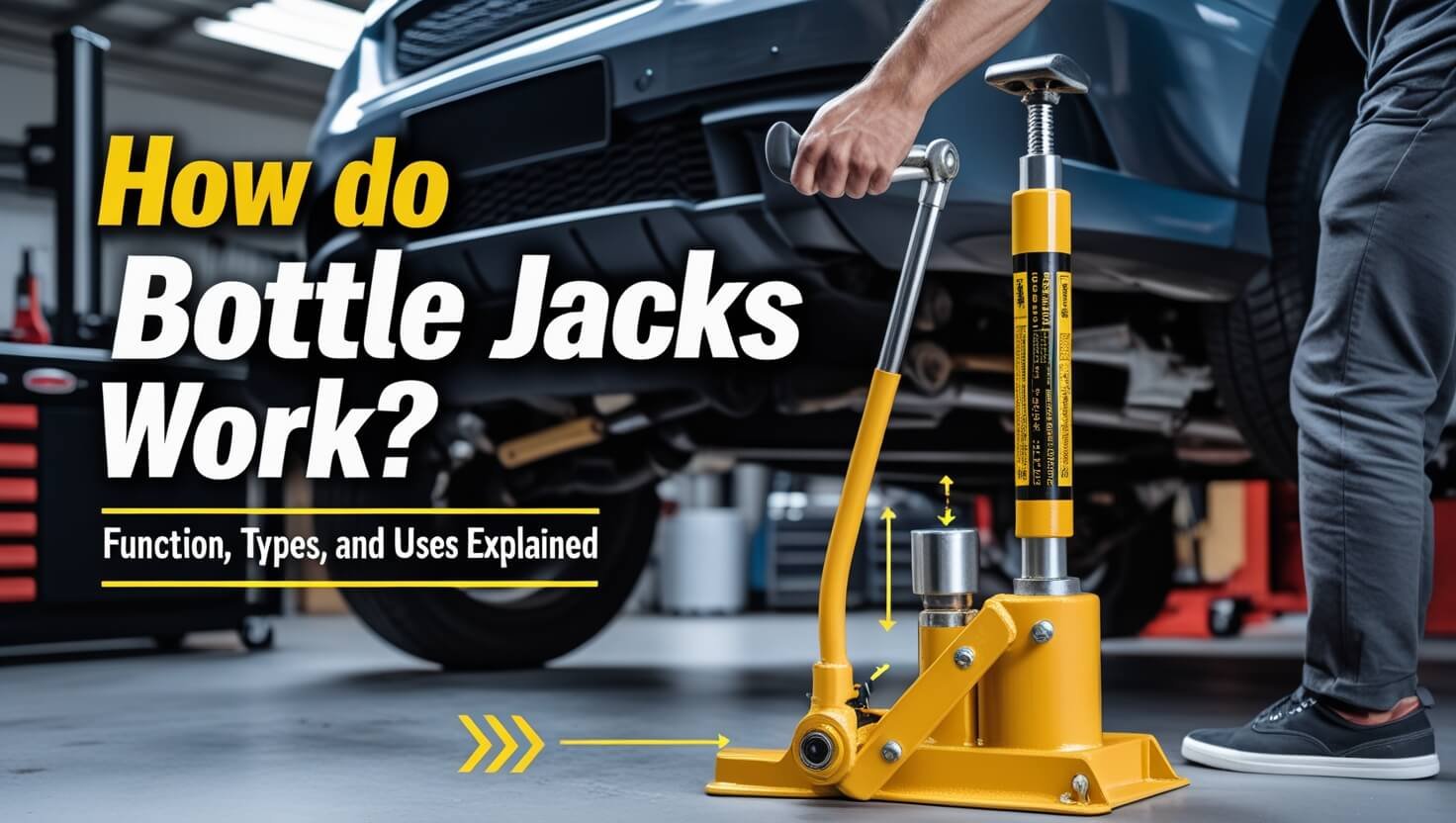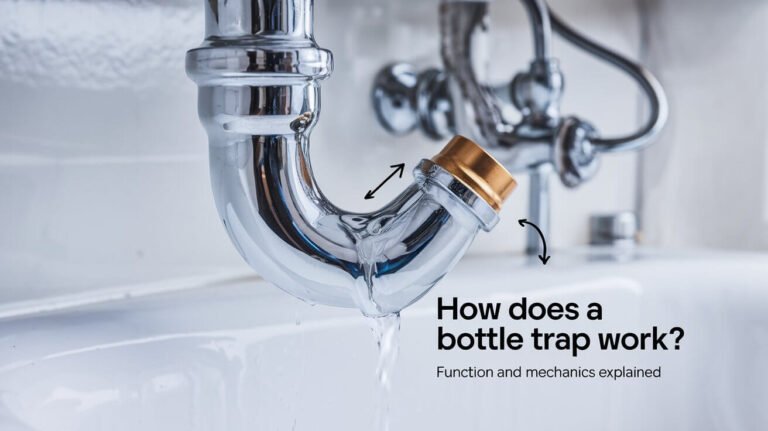How Do Bottle Jacks Work? Function, Types, and Uses Explained

Bottle jacks are amazing at lifting heavy loads with little effort. They work by using hydraulic force. This lets them lift big weights with just a small amount of effort.
To get how bottle jacks work, we need to look at their mechanics. These tools are key in industries like automotive and construction. They are vital for lifting heavy things.
By learning about bottle jacks, we appreciate the science and engineering behind them. These tools are essential for many industries.
Bottle jacks use hydraulic fluid or oil to lift heavy loads. Knowing how they work is important for safe use. They apply force through a hydraulic cylinder or screw thread.
Exploring bottle jacks, we see their design’s details. They make industries like automotive and construction more efficient. Bottle jack operation is key for daily tasks in these sectors.
Core Components of a Bottle Jack
The hydraulic bottle jack mechanism is complex. It has several key parts to work well. At its center is the hydraulic cylinder assembly. This includes a cylinder and a piston connected by a rod.
This assembly creates the force needed to lift heavy loads. The bottle jack operation also involves the ram and piston mechanism. They work together to lift the load.
The release valve system is also key. It lets you lower the load safely and in control. Knowing how these parts work together is vital for safe use.
Key Components of a Hydraulic Bottle Jack
- Hydraulic cylinder assembly
- Ram and piston mechanism
- Release valve system
In a hydraulic bottle jack, fluid pressure in a cylinder multiplies force. This lets you lift heavy loads safely and reliably. The bottle jack operation follows Pascal’s Law.
This law says pressure changes in a fluid are the same everywhere. It’s what makes the hydraulic bottle jack mechanism work.
| Component | Description |
|---|---|
| Hydraulic Cylinder Assembly | Consists of a cylinder and a piston connected by a rod |
| Ram and Piston Mechanism | Works together to lift the load |
| Release Valve System | Allows for the safe and controlled lowering of the load |
The Science Behind Hydraulic Force
The working principle of bottle jacks is based on hydraulic force science. This force is key in physics and used in many tools, like hydraulic jacks. It helps lift heavy loads. Pascal’s Law explains that pressure in a liquid spreads to all parts of it.
This law helps hydraulic jacks work. They use a small force to create a big force on objects. The force amplification depends on the piston areas, as Pascal’s law shows. By using leverage and Pascal’s law, a hydraulic bottle jack can lift heavy things.
Some important points about hydraulic force in bottle jacks are:
- Hydraulic fluid in a closed system works with two pistons. A smaller piston pushes on the fluid, and the pressure goes to a bigger piston. This makes the force stronger.
- The pressure in the cylinder of a hydraulic jack pushes up on the jack’s plate. This force helps lift objects.
- Hydraulic jacks can create huge forces with just a simple pump. But, they must be designed carefully to avoid breaking while in use.
The science behind bottle jacks is amazing. It shows how hydraulic force can make lifting tools powerful and efficient. By knowing about hydraulic force, we can see the engineering and design that goes into these devices.
How Do Bottle Jacks Work: Step-by-Step Operation
To understand how bottle jacks work, we need to break it down into simple steps. Lifting with these jacks requires focus and knowledge of their mechanics. The process includes setting up, using the pump, and lifting the load.
The first step is setting up the jack correctly. This means placing it under the load and making sure it’s aligned right. This step is key to avoid accidents and make lifting smooth. After setting up, you start using the hand pump to lift the load. The hydraulic fluid in the jack creates pressure, making lifting efficient.
Key Steps in the Lifting Process
- Initial setup: Position the jack under the load and ensure proper alignment.
- Pumping mechanism action: Use the hand pump to lift the load, taking care to maintain a steady and controlled pace.
- Load lifting sequence: Slowly lift the load to the desired height, monitoring the jack’s stability and the load’s position throughout the process.
By following these steps, you can safely and effectively use bottle jacks. They are useful in many areas, like cars, construction, and industry.
| Jack Type | Lifting Capacity | Industry Application |
|---|---|---|
| Hydraulic Bottle Jack | 2-20 tons | Automotive, Construction, Industrial |
| Pneumatic Bottle Jack | 1-10 tons | Agriculture, Medical, Warehouse |
Pressure Systems and Load Capacity
The hydraulic bottle jack mechanism is made to handle heavy loads. It’s key in many industries. The system includes a hydraulic cylinder and a pump, lifting heavy items together.
The load a jack can handle depends on its size and type. The pressure system also plays a big role.
When picking a hydraulic bottle jack, think about its load capacity and pressure system. Load capacity is very important. Going over the max weight can harm the jack.
Hydraulic bottle jacks come in different capacities. For example, a 32-Ton Hydraulic Air-Operated Bottle Jack is great for car repairs. A 20 Ton Air Hydraulic Bottle Jack is better for heavy-duty tasks.
When choosing a hydraulic bottle jack, consider a few things:
- Load capacity
- Clearance
- Lift height
- Orientation
- Manual or automatic operation
These factors help pick the right hydraulic bottle jack for your needs. Knowing about the pressure system and load capacity ensures safe use.
A 32-Ton Hydraulic Air-Operated Bottle Jack weighs 44.09 lbs and is 9.06″ x 8.66″ x 10.43″. It’s versatile for many industries.
In summary, the hydraulic bottle jack mechanism is essential in many fields. Knowing its pressure system and load capacity is key for safe and efficient use. By choosing the right hydraulic bottle jack, users get reliable lifting solutions.
Common Applications and Use Cases
Bottle jacks are handy tools used in many fields like cars, building, and making things. They are great for lifting heavy things because they are small and light. You can lift big loads with just a little effort thanks to their hydraulic power.
In car shops, bottle jacks help mechanics work on cars by lifting them up. Builders use them to move big machines and stuff around construction sites. Also, in big warehouses and factories, they help move heavy stuff around.
Key Industries
- Automotive: lifting with bottle jacks for vehicle maintenance and repair
- Construction: lifting heavy equipment and materials
- Industrial: lifting and moving heavy loads in warehouses and factories
Using bottle jacks has many advantages. They are small, light, and don’t cost a lot. They are also simple to use, which is why people like them for small jobs and occasional use. Bottle jacks are a must-have for anyone who needs to lift heavy things. Their flexibility makes them a key tool in many industries.
Safety Features Built Into Bottle Jacks
Safety is a big deal when it comes to bottle jacks. They are made with safety features to avoid accidents and ensure safe use. These include overload protection and pressure relief valves, which are key to preventing damage and injury.
Some important safety features to look for in bottle jacks are:
- Overload protection: This stops the jack from being overloaded, which can harm the jack and the person using it.
- Pressure relief valves: These valves let out extra pressure if the jack is overloaded, keeping the jack and the user safe.
- Sturdy construction: Bottle jacks are made of strong materials like steel and cast iron, making them durable and strong.
It’s important to follow safety tips when using bottle jacks. This includes checking them before use, keeping them lubricated, and not going over the maximum weight. Knowing how bottle jacks work and following safety rules helps users work safely and efficiently.
| Safety Feature | Description |
|---|---|
| Overload Protection | Prevents the jack from being overloaded, causing damage and injury |
| Pressure Relief Valves | Releases excess pressure in the event of an overload, preventing damage and injury |
| Sturdy Construction | Ensures durability and strength, preventing damage and injury |
By focusing on safety and understanding how bottle jacks work, users can have a safe and efficient experience.
Maintenance Requirements for Optimal Performance
Regular maintenance is key to keeping a bottle jack in top shape. This means checking the oil, cleaning the jack, and storing it right. Doing these things helps your hydraulic jack lift better and last longer.
For bottle jack operation, it’s vital to check and top off the hydraulic oil. The hydraulic bottle jack mechanism needs the right oil level to work well. Too much oil can cause leaks and harm the jack, so be careful when adding oil.
Here are some maintenance tips:
- Regularly check and refill the hydraulic oil levels.
- Clean the jack and area around it to keep dirt out of the system.
- Store the jack in a dry, safe spot to avoid damage and rust.
By sticking to these maintenance steps, you’ll keep your bottle jack running smoothly. Regular upkeep saves you time and money on fixes. It also makes your equipment more reliable and safe.
| Maintenance Task | Frequency | Importance |
|---|---|---|
| Oil Level Check | Regularly | High |
| Cleaning | After each use | Medium |
| Storage | After each use | High |
Troubleshooting Common Issues
When lifting with bottle jacks, it’s key to spot and fix common problems fast. Knowing how do bottle jacks work helps solve issues that come up while using them.
Issues like leaks, pressure loss, and damage to the hydraulic parts are common. These can happen due to low fluid, air in the system, or bad seals and valves.
Leak Detection
To find leaks, look at the jack’s seals and valves for damage or wear. Always check the hydraulic fluid level and add more if it’s low.
Pressure Loss Solutions
If you lose pressure, check for air in the system and bleed it out. Make sure moving parts are well-lubricated and use the right lubricants to avoid wear.
Repair Techniques
For damaged seals, replace them with new ones. If you see oil leaks or foaming, check for loose fittings, low fluid, or overheating. For big problems, get professional help.
| Common Issue | Cause | Solution |
|---|---|---|
| Leak | Damaged seals or valves | Replace seals or valves |
| Pressure Loss | Air trapped in the system | Bleed the jack |
| Damage to Hydraulic Cylinder Assembly | Low hydraulic fluid levels or improper use | Check and maintain fluid levels, use properly |
Regular checks and upkeep can stop common problems and make your bottle jack last longer. By knowing how do bottle jacks work and lifting right, you can avoid issues and lift safely and efficiently.
Comparing Bottle Jacks to Other Lifting Tools
There are many tools for lifting heavy loads, like hydraulic floor jacks and scissor jacks. Each has its own good points and bad points. The hydraulic bottle jack mechanism is popular because it’s small and easy to carry.
Bottle jacks are cheaper and easier to move than floor jacks. But, floor jacks can lift more and adjust to different heights. This makes them better for big jobs. The bottle jack operation is simple, perfect for lifting cars or heavy equipment.
Here is a comparison of the different types of jacks:
| Jack Type | Lifting Capacity | Height Adjustment | Portability |
|---|---|---|---|
| Bottle Jack | Up to 20 tons | Limited | High |
| Floor Jack | Up to 50 tons | Wide range | Low |
| Scissor Jack | Up to 10 tons | Limited | Medium |
In conclusion, the right jack depends on what you need. By looking at the hydraulic bottle jack mechanism and the bottle jack operation, you can pick the best jack for you.
Wrap UP
The bottle jack is a marvel of engineering, using hydraulic force to lift heavy loads. It’s used in many fields, like car repair, construction, mining, and transportation. Its ability to lift safely and efficiently makes it essential for both pros and DIY fans.
Need to lift your car, build a new structure, or move big equipment? A good bottle jack is key. With the right care, safety steps, and knowledge of how they work, these tools will last a long time. The article showed us the importance of understanding hydraulic force, design, and how to use them right.
As industries keep changing, the need for reliable lifting tools will grow. Bottle jacks are perfect for this, combining strength, accuracy, and ease of use. By knowing how to use them safely, you can handle tough lifting jobs with ease.




